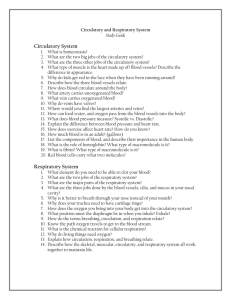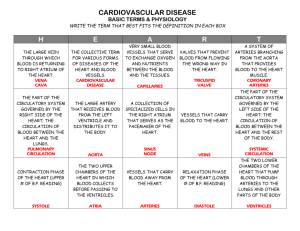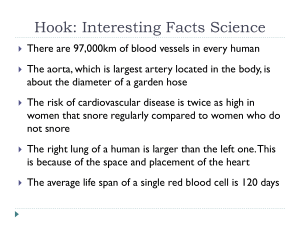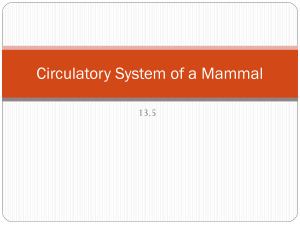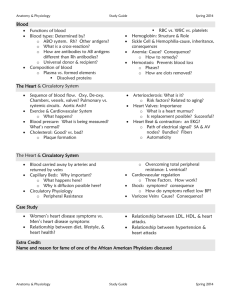THE CIRCULATORY SYSTEM
advertisement
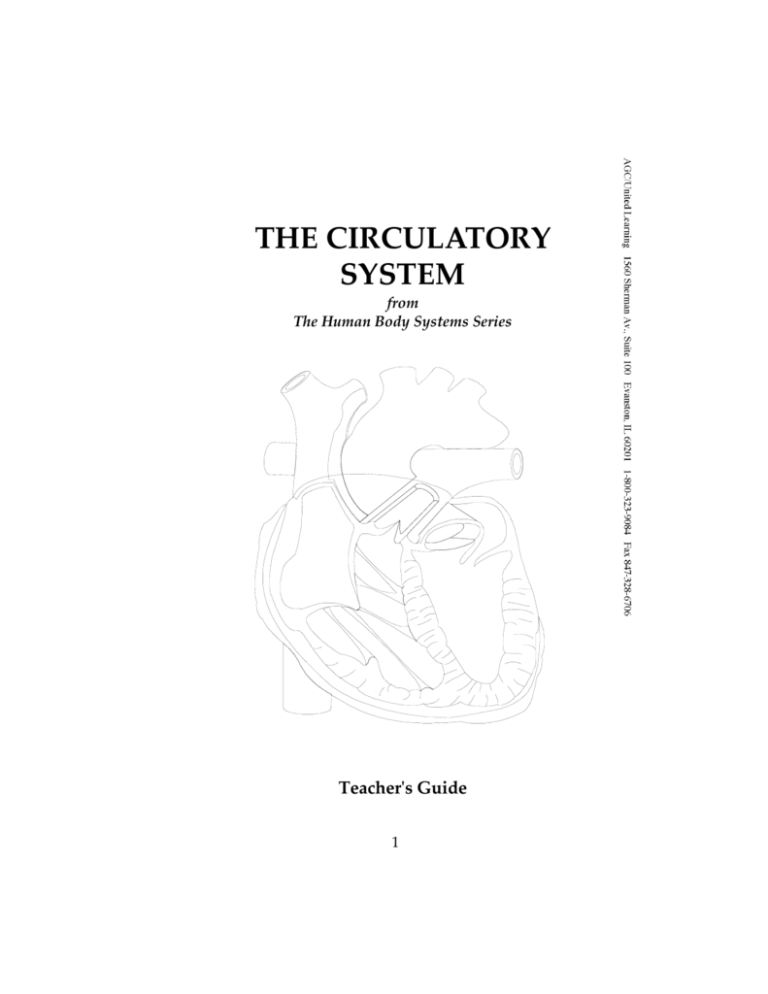
THE CIRCULATORY SYSTEM from The Human Body Systems Series Teacher's Guide 1 The Circulatory System from The Human Body Systems Series catalog # 3135 Published & Distributed by… AGC/UNITED LEARNING 1560 Sherman Avenue Suite 100 Evanston, IL 60201 1-800-323-9084 24-Hour Fax No. 847-328-6706 Website: http://www.agcunitedlearning.com E-Mail: info@agcunited.com 2 THE CIRCULATORY SYSTEM Grade Levels: 6 - 9 (Review for grades 10-12) Viewing Time: 20 minutes with video quiz INTRODUCTION This video is designed for use in grades 6-9 as an introduction to the major ideas and concepts associated with the human circulatory system, and for use in grades 10-12 as review. PROGRAM OBJECTIVES After viewing the video and participating in the lesson activities, the students will be able to… • Describe the function and workings of the circulatory system. • Identify the main parts of the circulatory system. • Identify the three types of blood vessels found in the human circulatory system. • Define key vocabulary terms associated with the circulatory system. SUMMARY OF THE VIDEO This video describes the functions of the human circulatory system. It is the main transport system of the body and is responsible for suppling the trillions of living cells in our bodies with the food and oxygen necessary for survival. In addition to bringing fresh supplies of food and oxygen, the circulatory system carries away from the cells waste products that must be eliminated from the body. The circulatory system works with the digestive system, the 3 respiratory system, and the excretory system to perform these functions. The center of the circulatory system is the four-chambered heart. The parts and functions of the heart are described and illustrated through the use of computer generated artwork and animation. The three types of blood vessels are presented as well as a discussion of the makeup of blood. Blood clotting and methods for maintaining a healthy circulatory system are presented at the end of the tape. INSTRUCTIONAL NOTES Before presenting this lesson to your students, we suggest that you preview the video and review this guide and the accompanying blackline master activities in order to familiarize yourself with their content. Duplicate any blackline masters you wish to distribute. If you plan to use the Video Quiz, which immediately follows the video presentation, you may wish to distribute Blackline Master 1, Video Quiz, before showing the video. As you review the materials presented in this guide, you may find it necessary to make some changes, additions, or deletions to meet the specific needs of your class. We encourage you to do so, for only by tailoring this program to your class will they obtain the maximum instructional benefits afforded by the materials. It is also suggested that the video presentation take place before the entire group under your supervision. The lesson activities grow out of the context of the video; therefore, the presentation should be a common experience for all students. 4 INTRODUCING THE VIDEO Ask the students to make a fist. Then ask them to open the fist. Ask them to do that procedure of making a fist and then opening it as quickly as they can for the next minute. After the minute, most people will recognize that the muscles in their fingers and hands are tired or fatigued. Now ask them to think about an organ in their body that never fatigues and works so hard that it pumps 2,000 gallons of blood everyday throughout their body. Of course, we are talking about the heart. The topic for today’s video is the heart and the rest of the circulatory system that is so essential to life. Present the video. The viewing time is 15 minutes for the program and about 5 minutes for the Video Quiz. BLACKLINE MASTER DESCRIPTIONS Most of the follow-up activities for this program are designed for middle school grades. If you use this program with an older audience, you will need to adapt the materials appropriately. • Blackline Master 1, Video Quiz, is to be used at the end of the video program. At the completion of the video there is a short ten-question quiz. The narrator will read the questions which are displayed on the screen. Students can use this sheet to record their answers. Answers to the questtions are provided in the Answer Key found on page 5. • Blackline Master 2, Vocabulary, is a collection of important vocabulary words from the video. You may want to distribute this sheet before viewing the video so students can listen for definitions. 5 • Blackline Master 3, Naming The Parts of a Heart, asks students to use the words at the bottom of the page to label the illustration of a heart. • Blackline Masters 4 qnd 5, Stages of a Heartbeat and Stages of a Heartbeat 2, are designed to be used together. Students are asked to describe what is happening during each of the four stages of a heartbeat. The first sheet provides illustrations of each stage and the second sheet provides spaces for students to record what is happening. • Blackline Master 6, Blood Types, is an information sheet that discusses a topic not covered in the video program, the ABO blood system. • Blackline Masters 7, Quiz, is the formal test for this unit of study. INTERNET ACTIVITIES 1. Visit The Heart website at http://johns.largnet.uwo.ca/shine/health/heart.htm for great information about the heart and the circulatory system. 2. The Heart and the Circulatory System provides history of human thought on the workings of the circulatory system at http://www.gene.com/ae This information can be accessed by typing the words "heart and the circulatory system" in the site's search engine. DISCUSSION QUESTIONS 1. Discuss how the circulatory system works with other systems to deliver food and oxygen to the living cells of the body. 6 2. Discuss how the cardiac muscle of the heart is different from other muscles found in the body. 3. Discuss how students can maintain healthy hearts and circulatory systems. Why would a balanced diet and exercise be important? ANSWER KEY Blackline Master 1, Video Quiz 1. The job of the circulatory system is to transport food and oxygen to all of the trillions of living cells in a human body. It also must pick up waste products from those cells so that they can be eliminated from the body. 2. Heart, blood, blood vessels. 3. Right atrium, right ventricle, left atrium, and left ventricle. 4. The lub-dub sound is the sound of heart valves closing. 5. Arteries, capillaries, veins. 6. One-way valves, and the fact that veins are between leg muscles so when a person walks, the contracting and relaxing muscles help push the blood along. 7. The first number is the pressure of blood as it is pushed by the ventricles. The other number is the pressure at rest while the ventricles are refilling. 8. 5 liters. 9. Plasma, red blood cells, white blood cells, and platelets. 10.Hemoglobin attracts and holds onto oxygen molecules. It carries the oxygen through the circulatory system. Blackline Master 2, Vocabulary 1. artery - blood vessel that carries blood away from the heart 2. vein - blood vessel that carries blood back to the heart 3. capillary - smallest blood vessel found between arteries and veins 4. atrium - one of two upper chambers of the heart 7 5. ventricle - one of two lower chambers of the heart 6. aorta - main artery of the body 7. plasma - yellowish fluid that makes up more than 50% the volume of blood; it contains nutrients, hormones, and minerals and is about 90% water 8. red blood cell - carries the oxygen throughout the circulatory system 9. white blood cell - these cells are the body's main defense against germs and bacteria 10. platelets - blood cells which help with blood clotting 11. coronary circulation - the heart needs a constant and fresh supply of blood which is delivered by the coronary circulation system 12. hemoglobin - a substance that attracts and holds onto oxygen molecules; hemoglobin is in the red blood cells 13. bone marrow - inside certain long bones of the body, the bone marrow is the site of blood cell production and storage 14. fibrin - long thread-like mesh that helps clot blood 15. clot - seals a wound by forming a thickened concentration of blood 16. pacemaker - an area of the heart that regulates or signals the beating of the heart 17. cardiac muscle - the heart 18. one-way valve - a valve that allows the flow of blood in only one direction 19. pulmonary arteries - arteries which carry carbon dioxide rich blood from the heart to the lungs 20. pulmonary veins - veins which carry the oxygen-rich blood from the lungs back to the heart 8 Blackline Master 3, Naming the Parts of the Heart Blackline Masters 4 & 5, Stages of the Heartbeat 1 and 2 Stage #1 : Blood enters the right and left atria. Blood that enters the right atrium is coming from the body and is carrying carbon dioxide. Blood entering the left atrium is returning from the lungs and is rich with oxygen. Stage #2: The blood moves from the atria into the two ventricles when one-way valves open up. Stage #3: The one-way valves close, trapping the blood in the ventricles. Stage #4: The other valves of the ventricles open. From the right ventricle, the blood is pushed to the pulmonary artery which carries the carbon dioxide-rich blood to the two lungs. The blood from the left ventricle is given a mighty push to carry it into the aorta, the main artery of the body. 9 Blackline Master 6, Blood Types Blood Type A B AB O Can Donate to Group A, AB B, AB AB A, B, AB, O Blackline Master 7, Quiz 1. The role of the circulatory system is to transport food and oxygen to the living cells of the body. It also collects waste products from the cells to be eliminated from the body. 2. Plasma is a yellowish fluid that makes up 50% of the volume of blood. Floating in the plasma are nutrients, hormones, and minerals. Red blood cells carry the oxygen throughout the body. White blood cells are an important part of the body’s immune system. They attack germs. Platelets help blood clot when there is a cut. 3. Blood enters the right atrium from veins that are returning blood to the heart. The blood moves through a oneway valve into the right ventricle, which pushes the blood into the pulmonary arteries that lead to the lungs. The blood goes into the lungs, where it releases carbon dioxide and picks up oxygen. The now oxygen-rich blood returns to the heart by entering the left atrium. It goes through a oneway valve and into the left ventricle where it will get a major push through a final valve and into the aorta, the major artery of the body. 4. Arteries carry blood away from the heart. They have to be strong but flexible because of the powerful push from the left ventricle. Capillaries are the smallest blood vessels, about the size of a single red blood cell. The transfer of nutrients, oxygen, and wastes takes place at the capil10 lary level. Veins are blood vessels that return blood to the heart. They contain one-way valves to prevent blood from flowing backwards. 5. If blood types that are not compatible are mixed, clumping chemicals anti-A and anti-B will recognize the other blood as foreign and cause it to clump. The clumping could lead to blockage in blood vessels. 6. The left ventricle must give the blood the major push it needs to travel throughout the circulatory system to all parts of the body. 7. If there are a lot of white blood cells present, then it indicates that the body is fighting off an infection and germs. 8. The first number is the measure of the strongest pressure during the time blood is forced out of the ventricles. The second number is taken during the rest period while the ventricles are refilling with blood. 9. Hypertension is used to describe people who have high blood pressure readings during periods of rest. This can be harmful to delicate body organs. 10. Eating foods low in fat can help avoid the clogging of arteries. Exercise can be very helpful to a muscle like the heart. SCRIPT OF VIDEO PRESENTATION THE CIRCULATORY SYSTEM Your body is made up of trillions of living cells and everyone of them needs food and oxygen to stay alive. Whether you are exercising, just sitting around, or even sleeping, the circulatory system is busy working to get fresh oxygen and food to all parts of the body. 11 It is the job of the circulatory system to transport food and oxygen to the cells and then to collect waste products so that they can be eliminated from the body. This system operates non-stop from before birth to death. If deprived of oxygen for just a few minutes, a cell will begin to die. This system is crucial to survival. The circulatory system is made up of three main parts or components: the heart, the blood, and the vessels through which the blood flows. Let’s begin our exploration by looking at the heart. THE HEART The heart is about the size of an adult’s fist and is located just to the left of the center of a human’s chest. The heart is protected by the rib cage. More than fifty percent of the heart’s weight is muscle. However, this is a special muscle called the cardiac muscle. It is made of muscle fiber that doesn’t become tired or fatigued after prolonged use. Muscles in your arms and legs are different, and after strenuous use they become fatigued. The heart can never become tired because it is constantly working night and day for your entire life. It beats at about 70 beats per minute during times of rest. During each of these beats, about 70 milliliters of blood are pumped out to the body. This graduated cylinder contains 70 milliliters of colored water to give you an idea of how much blood is pushed out of the heart with every beat. The rate of beating is controlled or regulated by an area of nerve tissue located in the upper-right side of the heart. This area is called the pacemaker and sends out signals to the heart muscle causing it to contract. If something happens to the pacemaker, an artificial or human-made pacemaker can be used, either inside the body or on the outside to send the necessary signals for heart movement. 12 The heart is made up of two pumps, one on the right side and one on the left side. A wall of thick tissue, called the septum, separates the heart into these two sides. There are two chambers found on each side, for a total of four chambers. The two upper chambers are called atria and the two lower chambers are called ventricles. In the right atrium, blood is collected as it returns from its trip throughout the body. This blood has very little oxygen, but is carrying carbon dioxide, a waste product released from the body’s living cells. The color of this blood is dark red. At the bottom of the right atrium is a one-way valve that opens to allow the blood into the lower chamber, called the right ventricle. The one-way valve will not permit the blood to flow backwards into the upper chamber. This is a muscular chamber that contracts with great force. It pushes the blood through the semilunar valve into the pulmonary artery. The pulmonary artery divides into two paths leading to the two lungs. The blood, rich with the waste product carbon dioxide, moves into the capillaries, or smallest blood vessels of the lungs. Here there is a gas exchange as the carbon dioxide passes from the blood into the lungs where it will be exhaled from the body. The air breathed into the lungs has oxygen in it. The oxygen moves into the blood to be carried to the body’s cells. The pulmonary veins bring the now oxygen-rich blood back to the heart. It enters the left atrium and then moves into the left ventricle. The blood is now a bright red because it is rich with oxygen. The left ventricle contracts, forcing the blood into the aorta, which is the largest artery in the body. The blood is now on its way throughout the body. The left ventricle actually works about six times harder than the right ventricle because it is responsible for giving the blood the push it needs to travel throughout the whole body. 13 The right ventricle is merely sending the blood into the pulmonary arteries which take it a short distance to the lungs. The lub-dub sound that is heard when listening to the heart is the sound of the different valves shutting as blood flows through them. The valves are designed only to allow blood to flow in one direction. The four stages of a heartbeat as described above take about a second to occur. BLOOD VESSELS The blood travels through the body in a continuous system of tubes called blood vessels. This system is so huge that if one person’s blood vessels were stretched out straight, they would reach almost half way to the moon. There are three types of blood vessels: arteries, veins, and capillaries. Arteries are large blood vessels that carry the blood away from the heart. Arteries divide into smaller and smaller vessels, until they are so small they can only be seen through a microscope. These vessels are called capillaries. There are so many of these vessels that most living cells of the body are close to capillaries. The capillaries rejoin to form veins, which are the blood vessels that return blood to the heart. In this diagram, the arteries are shown in red to represent oxygen-rich blood and the veins are shown in blue to show oxygen-poor blood. The largest artery is called the aorta. It is about 1 inch in diameter and receives the push of blood from the left ventricle. There is quite a bit of pressure behind this push, so arteries are designed to be flexible. They expand and then move back to their original sizes and shapes, which provides even more push. Some of the blood is directed immediately back to the heart to provide it with nutrients and oxygen. The heart cells need to be continuously supplied with nourishment. 14 Through coronary circulation, blood is supplied to the blood vessels of the heart. If the cells of the heart aren’t supplied with oxygen or nutrients, a heart attack can result. Heart attacks are a leading cause of death in the United States. They can be caused by blood clots that block blood vessels or buildup of cholesterol, fibrin, or other material in blood vessels can narrow the path or openings in the vessels. Remember that one of the critical jobs of the circulatory system is to transport oxygen and food to all living cells and then to collect waste products, such as carbon dioxide. The exchange of gases takes place in the capillaries. These vessels are so small that they are only one cell thick. This makes the transfer of materials possible. There are so many capillaries that every living cell in the body is within their reach. The capillaries are so thin that red blood cells have to squeeze through them one cell at a time. After blood cells have delivered nourishment and picked up wastes, they move into larger vessels called veins. Veins return blood to the heart. They are structured similarly to arteries, with three layers of muscle and connective tissue. Veins must overcome the pull of gravity to get the blood back to the heart. The push from the heart that propels the blood through the arteries is no longer much of a factor. There are two things that help to move the blood through the veins. The larger veins have one-way valves that prevent the blood from flowing backwards. The veins are located between skeletal muscles, and when the muscles contract, they force the blood forward through the veins and towards the heart. If a person stands still for awhile, the blood will collect in his or her feet and ankles. If this continues and the brain doesn’t get enough blood, a person might faint. When people walk, jog, or run, the muscles in the legs contract 15 and relax, which causes the veins to be squeezed and released. This causes the blood to move along the vein towards the heart. BLOOD PRESSURE To move the blood through this network of vessels, a great deal of force and pressure is required. The force is provided by the heart and is at its highest when the ventricles contract, forcing blood out of the heart and into the arteries. Then there is a drop in pressure as the ventricles refill with blood for the next heartbeat. Doctors measure the blood pressure with a device called a sphygmomanometer. They always measure blood pressure in the upper arm artery. Blood pressure varies throughout the body, so a standard place must be used so that a person’s blood pressure can be compared over time and with other people. There are two pressure readings. One measures the strongest pressure during the time blood is forced out of the ventricles. The second reading is taken during the rest period, as the ventricles refill with blood. The first reading is called a systole and the reading at refill is called a diastole. The numbers are written together, such as 120 over 80, which happens to be the blood pressure of a healthy young adult. Blood pressure will change according to the activity in which the person is engaged, such as resting, walking, and running. People who have high blood pressure readings during periods of rest are said to have hypertension. This can be harmful to delicate body organs, so people are advised to do things to correct the condition. This may involve losing weight and exercising more often to return the blood pressure to normal readings. 16 BLOOD The average adult body contains about five liters of blood. The liquid in these five bottles represents how much five liters would equal. Blood is made up of four components: plasma, red blood cells, white blood cells, and platelets. Plasma makes up more than half the volume of blood. It is a yellowish fluid that is 90 percent water. Floating in the plasma are nutrients, hormones, and minerals. Red blood cells are very small and very numerous. In an area the size of a pinhead, you would find five million red blood cells. The average human body has more than 25 trillion red blood cells at any given time. Red cells have an unusual shape. They are disk-like, with a flattened interior. This design helps them to fold over when traveling through the small space of a capillary. They live for about three to four months and then die. Old red cells are broken up in the liver, spleen, and bone marrow, where some of their contents are reused to make new cells. New red blood cells are made in the marrow of some bones. New red cells are created at the rate of two million every second. These cells are very important because they carry the oxygen throughout the body. Red blood cells contain hemoglobin, which attracts oxygen molecules. So oxygen attaches to the hemoglobin and is carried to living cells of the body, where the oxygen is released to the cells through the capillaries. White blood cells are larger than red cells and are the body’s main defense against germs. Bacteria and viruses, which are commonly known as germs, can enter the body through cuts, the nose, throat, and intestines. Germs can cause infections. Blood will quickly carry white blood cells to an area of the body at which germs are invading. The white blood cells attack germs. There are different types of white blood cells. The lymphocytes create antibodies that attach 17 to the germ and either break them apart or clump them so that other white cells can eat the germs. Some white blood cells live only a few hours, while others can live for years. They are made in bone marrow like red blood cells. White blood cells are an important part of our bodies’ immune system. Platelets are smaller than red blood cells and help blood to clot when there is a cut. When we are injured with a cut, the platelets immediately help to begin a series of chemical reactions that stop the bleeding. There are chemicals called clotting factors found in the plasma. One forms fibrin, which is made up of long threads that form a net-like mesh that traps blood cells and platelets to seal the break. This eventually becomes a clot that seals the wound while the vessel is repaired. When the cut is on the skin, the clot becomes a scab because it hardens in air. This is the body’s way of stopping the loss of blood when you are injured. If there is a severe cut, you must act quickly to avoid the loss of large amounts of blood. The best way to stop bleeding is to apply pressure directly to the wound. A clean cloth should be used to avoid infection. Sometimes people are confused about what to do with a nose bleed. The best thing to do is to pinch the nostrils together with the head held straight. A HEALTHY CIRCULATION SYSTEM There are things you can do to help maintain a healthy circulatory system. Watching your diet is an especially good thing to do. Eating foods low in fat can help you to avoid the clogging of arteries. It is a good idea to avoid becoming overweight. One of the best things to do is exercise. The heart is a muscle and, like all muscles in the body, exercise can be beneficial to it. You strengthen the heart with exercise. Swimming, jogging, and biking are all good ways to make your heart stronger. 18 SUMMARY The circulatory system is a transport system that keeps every one of the trillions of living cells in your body alive and healthy. A vast network of blood vessels that reaches out to every part of your body, the circulatory system carries oxygen and food to the cells and collects carbon dioxide and other wastes for disposal. The system also defends the body against disease. There is far more to the circulatory system than the lub-dub sound of our hearts. VIDEO QUIZ Students may write the answers to the following questions on a separate piece of paper or on the duplicating master entitled Video Quiz. Question 1: What is the job of the circulatory system? Question 2: What are the three main parts of the circulatory system? Question 3: Name the four chambers of the heart. Question 4: What is the lub-dub sound we hear when listening to the heart? Question 5: Name the three types of blood vessels. Question 6: What two things help the blood in veins return to the heart? Question 7: What do the two numbers recorded while measuring blood pressure represent? For instance, a healthy young adult might have a blood pressure of 120 over 80. Question 8: How much blood is contained in an average adult? 19 Question 9: What are the four components of blood? Question 10: What does the hemoglobin in red blood cells do to help the circulatory system? 20 1 Name ________________ Date _________________ THE CIRCULATORY SYSTEM Video Quiz Directions: At the conclusion of the videotape there will be a short quiz with these questions. Write your answers in the space provided. Use the back of this sheet if necessary. Question 1: What is the job of the circulatory system? Question 2: What are the three main parts of the circulatory system? Question 3: Name the four chambers of the heart. Question 4: What is the lub-dub sound we hear when listening to the heart? Question 5: Name the three types of blood vessels. Question 6: What two things help the blood in veins return to the heart? Question 7: What do the two numbers recorded while measuring blood pressure represent? For instance, a healthy young adult might have a blood pressure of 120 over 80. Question 8: How much blood is contained in an average adult? Question 9: What are the four components of blood? Question 10: What does the hemoglobin in red blood cells do to help the circulatory system? THE CIRCULATORY SYSTEM from The Human Body Systems Series ©1997 AGC/United Learning 1560 Sherman Av., Suite 100 Evanston, IL 60201 1-800-323-9084 Fax 847-328-6706 www.agcunitedlearning.com e-mail: info@agcunited.com 2 Name ________________ Date _________________ THE CIRCULATORY SYSTEM Vocabulary Directions: Write a definition for each of the terms listed below: 1. artery2. vein3. capillary4. atrium5. ventricle6. aorta7. plasma8. red blood cell9. white blood cell10. platelets11. coronary circulation12. hemoglobin13. bone marrow14. fibrin15. clot16. pacemaker17. cardiac muscle18. one-way valve19. pulmonary artery20. pulmonary veinsTHE CIRCULATORY SYSTEM from The Human Body Systems Series ©1997 AGC/United Learning 1560 Sherman Av., Suite 100 Evanston, IL 60201 1-800-323-9084 Fax 847-328-6706 www.agcunitedlearning.com e-mail: info@agcunited.com 3 Name ________________ Date _________________ THE CIRCULATORY SYSTEM Naming The Parts Of The Heart Directions: Use the terms in the box at the bottom of the page to label the diagram of the heart. Aorta Pulmonary Artery to Left Lung Septum Right Atrium Pulmonary Artery to Right Lung Semilunar Valve Left Atrium Right Ventricle Left Ventricle THE CIRCULATORY SYSTEM from The Human Body Systems Series ©1997 AGC/United Learning 1560 Sherman Av., Suite 100 Evanston, IL 60201 1-800-323-9084 Fax 847-328-6706 www.agcunitedlearning.com e-mail: info@agcunited.com 4 Name ________________ Date _________________ THE CIRCULATORY SYSTEM Stages of a Heartbeat Directions: In less than a second the human heart goes through four stages of activity. Use the following pictures to help you describe those stages of a heartbeat. Use Blackline Master 5, "Stages of a Heartbeat 2," and write down a description of what is happening during each numbered stage. #1 #2 #3 #4 THE CIRCULATORY SYSTEM from The Human Body Systems Series ©1997 AGC/United Learning 1560 Sherman Av., Suite 100 Evanston, IL 60201 1-800-323-9084 Fax 847-328-6706 www.agcunitedlearning.com e-mail: info@agcunited.com 5 Name ________________ Date _________________ THE CIRCULATORY SYSTEM Stages of a Heartbeat 2 Directions: Use the space provided to write what is happening during each of the four stages of a heartbeat. Refer to the first page and the drawings on those pages for assistance in writing your descriptions. Stage #1: Stage #2: Stage #3: Stage #4 THE CIRCULATORY SYSTEM from The Human Body Systems Series ©1997 AGC/United Learning 1560 Sherman Av., Suite 100 Evanston, IL 60201 1-800-323-9084 Fax 847-328-6706 www.agcunitedlearning.com e-mail: info@agcunited.com 6 Name ________________ Date _________________ THE CIRCULATORY SYSTEM Blood Types If a person is severely injured or ill, he/she may require blood from another person. This is called a blood transfusion and it is usually done because the injured person has lost a great deal of blood. Before a transfusion can take place, doctors must determine the blood types of the donor and recipient to be certain the blood is similar. The ABO blood system was established by an American scientist, Karl Landsteiner. He grouped the four human blood types according to the proteins on the outer coat of their red blood cells. He ran a series of experiments that showed that when mixing red blood cells from one person with the plasma of another person, sometimes things went smoothly and other times the blood clotted and clumped up. This clotting would be a dangerous situation because it could mean blood vessels might be blocked leading to series consequences. He ran further experiments and found that not all red blood cells contain the same proteins on their outer coatings. He also found that plasma may contain two different proteins that are needed for clumping cells. This clumping or clotting is necessary when there is a a threat of a foreign invader, such as bacteria or germs. Lansteiner named the proteins on the red blood cells "A" and" B." He named the proteins in the plasma anti-A and anti-B, depending on how they reacted with the A and B proteins from the blood. For instance, if a person with type A blood receives blood from a type B donor, the anti-B chemicals in the plasma of the type A person will identify the type B red blood cells as foreign. The anti-B chemicals will cause the type A red cells to clump. So as you can see, it is important that during a transfusion a person only receives blood that is compatible with his or her blood type. The chart below shows the ABO blood system. Blood Type Proteins on red blood cells Plasma Chemicals Can Accept Transfusions From Group A A Anti-B A, O B B Anti-A B, O AB A, B None A, B, AB, O O None Anti-A, Anti-B Directions: Can Donate Blood To Group O Fill in the last column labeled "Can Donate Blood to Group." THE CIRCULATORY SYSTEM from The Human Body Systems Series ©1997 AGC/United Learning 1560 Sherman Av., Suite 100 Evanston, IL 60201 1-800-323-9084 Fax 847-328-6706 www.agcunitedlearning.com e-mail: info@agcunited.com 7 Name ________________ Date _________________ THE CIRCULATORY SYSTEM Quiz Directions: Write a few sentences about each of the following topics. Use the back of this sheet if necessary. 1. What is the role of the circulatory system? 2. What are the four major components of blood and what are their functions? 3. Describe the path of blood through the heart. Be sure to identify the four chambers of the heart. 4. What are the three types of blood vessels? How are they different and how are they designed to carry out their function? 5. Why must blood be matched before a blood transfusion? 6. Why is the left ventricle the hardest working heart chamber? 7. Why do doctors often do blood tests to count white blood cells? Why would such a count be helpful? 8. It is recommended that blood pressure be measured at least once a year. There are two numbers recorded during this process. What do these numbers represent? 9. What is hypertension? 10. Why is exercise and a healthy diet important to maintaining a strong circulatory system? THE CIRCULATORY SYSTEM from The Human Body Systems Series ©1997 AGC/United Learning 1560 Sherman Av., Suite 100 Evanston, IL 60201 1-800-323-9084 Fax 847-328-6706 www.agcunitedlearning.com e-mail: info@agcunited.com

